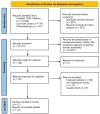Comparing the Safety and Efficacy of L-Glutamine, Voxelotor, and Crizanlizumab for Reducing the Frequency of Vaso-Occlusive Crisis in Sickle Cell Disease: A Systematic Review
- PMID: 35706735
- PMCID: PMC9187358
- DOI: 10.7759/cureus.24920
Comparing the Safety and Efficacy of L-Glutamine, Voxelotor, and Crizanlizumab for Reducing the Frequency of Vaso-Occlusive Crisis in Sickle Cell Disease: A Systematic Review
Abstract
Sickle cell disease (SCD) is a group of inherited red blood cell disorders affecting millions worldwide. The median life expectancy of someone with SCD remains significantly low despite improvements in standards of care and the implementation of hydroxyurea therapy. Notably, a 20-year interval existed (after the implementation of hydroxyurea therapy) prior to the approval of other sickle cell medications, namely, l-glutamine, voxelotor, and crizanlizumab. In this systematic review, these new medications' impact on the occurrences of vaso-occlusive crisis (VOC) events were analyzed and the adverse events of each were noted. Further, a secondary analysis was conducted to determine the effect of combination therapies, whether synergistic, antagonistic, or additive. The systematic review was conducted following the PRISMA 2020 guidelines. The effect-based and dose-effect-based approaches were utilized to determine the combined drugs combination index based on the recommended dosage to achieve an efficacy of 50%. L-glutamine and crizanlizumab were effective in reducing the frequency of VOC (p= 0.0216 and p = 0.02). Voxelotor effect on the reduction of VOC occurrences was not significant, however, its effect on increasing hemoglobin levels was significant (p= <0.001). In all three therapies, pain was the most common adverse event reported by participants. The analysis of combination therapies revealed that voxelotor plus l-glutamine was synergistic, voxelotor plus crizanlizumab was antagonistic, and l-glutamine plus crizanlizumab was additive. Thus, voxelotor plus l-glutamine combination therapy may be more beneficial to sickle cell disease patients. As such, robust combination drug studies for approved therapies used in SCD should be initiated with a specific focus on voxelotor plus l-glutamine. Additionally, the development of medications that lessen the pain burden in sickle cell disease patients should also be prioritized.
Keywords: combination therapy; crizanlizumab; l-glutamine; sickle cell; vaso-occlusive crisis; voxelotor.
Copyright © 2022, Dick et al.
Conflict of interest statement
The authors have declared that no competing interests exist.
Figures







Similar articles
-
Recent Advances in Sickle-Cell Disease Therapies: A Review of Voxelotor, Crizanlizumab, and L-glutamine.Pharmacy (Basel). 2022 Sep 26;10(5):123. doi: 10.3390/pharmacy10050123. Pharmacy (Basel). 2022. PMID: 36287444 Free PMC article. Review.
-
Impact of Different Definitions of Vaso-Occlusion on Efficacy Assessments in Sickle Cell Disease Clinical Trials.Adv Ther. 2025 May;42(5):2490-2499. doi: 10.1007/s12325-025-03162-2. Epub 2025 Mar 27. Adv Ther. 2025. PMID: 40146367 Free PMC article. Review.
-
Cost-effectiveness of l-glutamine versus crizanlizumab for adults with sickle cell disease: model focused on reducing pain episode costs from Qatar's healthcare perspective.SAGE Open Med. 2024 May 6;12:20503121231224551. doi: 10.1177/20503121231224551. eCollection 2024. SAGE Open Med. 2024. PMID: 38711465 Free PMC article.
-
Systematic Review of Crizanlizumab: A New Parenteral Option to Reduce Vaso-occlusive Pain Crises in Patients with Sickle Cell Disease.Pharmacotherapy. 2020 Jun;40(6):535-543. doi: 10.1002/phar.2409. Epub 2020 May 20. Pharmacotherapy. 2020. PMID: 32350885
-
Contemporary Management and Prevention of Vaso-Occlusive Crises (VOCs) in Adults With Sickle Cell Disease.J Pharm Pract. 2023 Feb;36(1):139-148. doi: 10.1177/08971900211026644. Epub 2021 Jun 21. J Pharm Pract. 2023. PMID: 34151636 Review.
Cited by
-
Emergency Presentations of Pediatric Sickle Cell Disease in French Guiana.Diseases. 2025 May 4;13(5):142. doi: 10.3390/diseases13050142. Diseases. 2025. PMID: 40422574 Free PMC article.
-
Mitochondria: Emerging Consequential in Sickle Cell Disease.J Clin Med. 2023 Jan 18;12(3):765. doi: 10.3390/jcm12030765. J Clin Med. 2023. PMID: 36769414 Free PMC article. Review.
-
Beyond Childhood: Adult and Adolescent Sickle Cell Disease and Outcomes in Northern Ghana.EJHaem. 2025 Mar 21;6(2):e70023. doi: 10.1002/jha2.70023. eCollection 2025 Apr. EJHaem. 2025. PMID: 40123794 Free PMC article.
-
Effects of GBT1118, a voxelotor analog, on bone disease in sickle cell disease mice.Sci Rep. 2024 Sep 27;14(1):22330. doi: 10.1038/s41598-024-69589-9. Sci Rep. 2024. PMID: 39333172 Free PMC article.
-
A Review of the Relationship between the Immune Response, Inflammation, Oxidative Stress, and the Pathogenesis of Sickle Cell Anaemia.Biomedicines. 2023 Aug 29;11(9):2413. doi: 10.3390/biomedicines11092413. Biomedicines. 2023. PMID: 37760854 Free PMC article. Review.
References
-
- Data & statistics on sickle cell disease [Internet]. Centers for Disease Control and Prevention. Centers for Disease Control and Prevention. [ Sep; 2021 ];https://www.cdc.gov/ncbddd/sicklecell/data.html 2020
-
- Ashorobi D, Bhatt R. Treasure Island, FL: StatPearls; 2021. Bone Marrow Transplantation In Sickle Cell Disease.
-
- American Society of Hematology. Longevity for those with sickle cell disease linked to care maintenance and family involvement. [ May; 2022 ];Fitzmaurice S. http://2016202118 American Society of Hematology. 2016
Publication types
LinkOut - more resources
Full Text Sources
Research Materials
